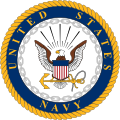FLTCYBER's roots are in the namesake of its force provider, U.S. Tenth Fleet, which was organized in 1943 to coordinate the allied response to the German U-boat threat and ensure access to the shipping lanes of the Atlantic.
Today, FLTCYBER and the modern U.S. Tenth Fleet ensure the Navy and the Nation have access to systems in the cyber domain.
The creation of USCYBERCOM and FLTCYBER
Department of Defense cyber operations came together under a single organization on 1 October 2000, when United States Space Command (USSPACECOM) formally took control of the Department of Defense computer network attack activities from the Joint Staff. USSPACECOM was eventually dissolved and some its functions merged into the reorganized United States Strategic Command (USSTRATCOM) 1 October 2002. [9] [10]
Navy Cyber operations were originally the responsibility of Naval Computer and Telecommunications Command, Naval Security Group and Naval Space Command, which were combined with 20 other commands into the Naval Network Warfare Command (NETWARCOM) in 2002 to unify network operations, offensive and defensive cyberspace operations, space operations and cryptologic/signals intelligences.
In 2005, with the alignment of Naval Security Group, NETWARCOM brought the former Naval Security Group Activities (NSGAs) under its umbrella and the mission of the command fundamentally changed, making it the Navy's lead command for information operations, networks and space. [11]
After extensive study, Secretary of Defense Robert Gates directed the creation of a new sub-unified command, USCYBERCOM on 12 November 2008, to operate under the authority of USSTRATCOM.
FLTCYBER was officially created as the Navy component to USCYBERCOM on 29 January 2010. [12] Chief of Naval Operations Adm. Gary Roughead named Vice Adm. Bernard J. McCullough III as the commander of both FLTCYBER and U.S. Tenth Fleet. All subsequent commanders have led FLTCYBER and U.S. Tenth Fleet simultaneously.
In August 2017, President Donald J. Trump announced the elevation of USCYBERCOM from a sub-unified command under USSTRATCOM to a Unified Combatant Command responsible for cyberspace operations. FLTCYBER remains the Navy service component to USCYBERCOM. [13]
In April 2019, Navy Space Command (NAVSPACECOM) was established as the service component of the USSPACECOM, while being commanded by the head of FLTCYBER. Since 2019 the Commander, FLTCYBER, has also simultaneously been Commander, NAVSPACECOM, though the latter post was not formally established until January 2023. [14] [15]














